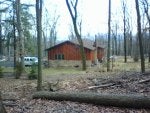Wondering if any of you chimney guys have ever looked into a situation like this.
3-4 years ago, my neighbor tore down the existing house and built a new one. The chimney is 25-30' tall built to code, and draws nicely for his basement woodburner. However, under almost all weather conditions, the smoke exits the top and immediately curls downward. In less than one heating season, the top 5' of the chimney was completely black.
Last fall, he added a several foot tall metal extension, but the smoke still falls immediately. The chimney on the old house didn't behave that way, nor do any of the neighbors'.
Barometric pressure doesn't seem to have much effect at all. The only factor I can think of that's significantly different from when the old house was there is that he has cut down a large percentage of the trees on his lot (we're in an oak forest on a mountainside).
3-4 years ago, my neighbor tore down the existing house and built a new one. The chimney is 25-30' tall built to code, and draws nicely for his basement woodburner. However, under almost all weather conditions, the smoke exits the top and immediately curls downward. In less than one heating season, the top 5' of the chimney was completely black.
Last fall, he added a several foot tall metal extension, but the smoke still falls immediately. The chimney on the old house didn't behave that way, nor do any of the neighbors'.
Barometric pressure doesn't seem to have much effect at all. The only factor I can think of that's significantly different from when the old house was there is that he has cut down a large percentage of the trees on his lot (we're in an oak forest on a mountainside).





